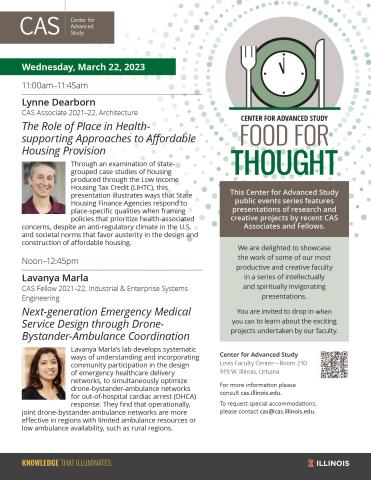Food for Thought: Lynne Dearborn and Lavanya Marla
Center for Advanced Study
Levis Faculty Center, Room 210
919 W. Illinois, Urbana
11:00am, Lynne Dearborn, The Role of Place in Health-Supporting Approaches to Affordable Housing Provision
A complicated historical relationship between health and place in the U.S. leads us to implicitly believe that, owing to their residential choices, low-income and minority individuals bear responsibility for their health outcomes. Through an examination of state-grouped case studies of housing produced through the Low Income Housing Tax Credit (LIHTC), this presentation illustrates ways that State Housing Finance Agencies respond to place-specific qualities when framing policies that prioritize health-associated concerns, despite an anti-regulatory climate in the U.S. and societal norms that favor austerity in the design and construction of affordable housing. Likewise, developers and designers of this housing respond to local interwoven social, cultural, and environmental conditions when they craft and construct LIHTC-supported affordable housing.
Noon, Lavanya Marla, Next-generation Emergency Medical Service Design through Drone-Bystander-Ambulance Coordination
Unmanned technology such as drones have demonstrated potential to improve response to time-sensitive emergencies, such as out-of-hospital cardiac arrest (OHCA), which kills over 300,000 individuals in the US annually. Drones facilitate early medical intervention by delivering an automated external defibrillator (AED) before ambulance arrival, but they require a willing bystander to apply the AED. Prior research on designing drone-enabled AED networks assumes that a bystander is always available at scene, although historical bystander participation is low. We develop systematic ways of understanding and incorporating community participation in the design of emergency healthcare delivery networks, to simultaneously optimize drone-bystander-ambulance networks for OHCA response. We find that operationally, joint drone-bystander-ambulance networks are more effective in regions with limited ambulance resources or low ambulance availability, such as rural regions. Adding a small number of drones may be more effective than adding many ambulances, in such regions with lower incidence rates spread over large areas.
CAS Associate 2021-22
Architecture
CAS Fellow 2021-22
Industrial & Enterprise Systems Engineering

